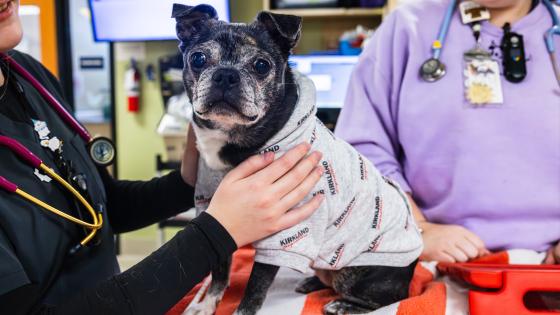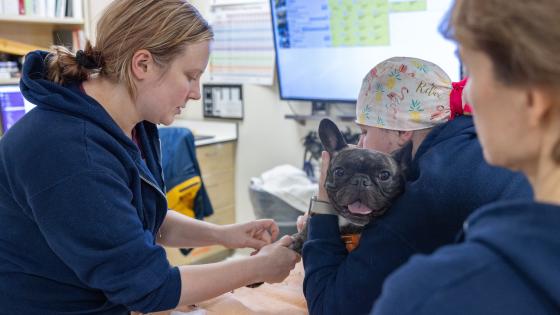
What’s Up With the Upchuck?
As a 24-hour emergency hospital, DoveLewis treats more cases of vomiting than any other type of injury or illness. Throwing up can be a regular occurrence for both cats and dogs, but it can also be a sign of a more serious issue.
It’s common for a dog to vomit a few times a year. They may have had a passing virus or ingested something their stomach didn’t agree with. Cats, on the other hand, may vomit more frequently. There isn’t a cat owner out there who isn’t familiar with the dreaded hairball. But knowing the difference between a common occurrence and a serious symptom can help you decide if your pet needs emergency veterinary care.
Productive vs. non-productive vomiting.
One thing to consider is the contents of the vomit. Does it contain a hairball, food or other substance? This is known as productive vomiting. If this happens, watch your pet carefully, but it may not be a sign for immediate alarm. However, if your animal is hacking or wretching without much substance in their vomit – non-productive vomit – this is concerning, and your animal should most likely be checked by a veterinarian.
Remove food and water.
Vomiting generally produces more vomiting. If an animal eats or drinks after throwing up (even if it harmless vomiting), they will most likely throw up again. Let your pet’s stomach settle by removing their access to food and water for eight to 12 hours. This will also help you evaluate the severity of the vomiting. Monitor them closely during this time. If the pet seems to recover and return to a normal routine, it was most likely a harmless incident. However, if they continue to vomit, it could indicate a more serious issue.
Consider the circumstances.
No one likes to likes to hear the answer “it depends” when they ask a question, especially about their animal’s health. But when it comes to vomiting, there are many different factors to consider. What is your pet’s health history? Does your pet have a pre-existing condition? Has your pet recently ingested something they shouldn’t have? Is your pet acting differently after vomiting, or do they return to normal? You know your pet best. If the vomiting seems abnormal or severe, don’t hesitate to call your vet or DoveLewis immediately.
Other symptoms that may warrant a trip to the ER:
- Vomiting more than three times in one day
- Constant retching or hacking
- Blood in vomit
- Vomiting follows eating something inappropriate or a recent change in diet
Seek veterinary care if vomiting is accompanied by these symptoms:
- Diarrhea
- Lethargy
- Pale gums
- Distended abdomen
- Weight loss
- Change in appetite and water intake
Why is my pet vomiting?
Ask any doctor, and they will tell you that’s a loaded question. In animals, vomiting can be a warning sign and/or a reaction to numerous illnesses. Aside from the typical hairball or overeating issue, vomiting can be caused by ingesting something inappropriate (from grass to corn cobs to socks), a variety of gastrointestinal issues, food allergies, inflammatory bowel disease, hormonal imbalances, pancreatitis, liver disease and kidney failure.
The most important thing to know:
Vomiting should always be closely monitored. If you have any concerns, call your veterinarian or DoveLewis immediately. Vomiting can be an indication of more serious issues, so it’s always better to be safe than sorry.



